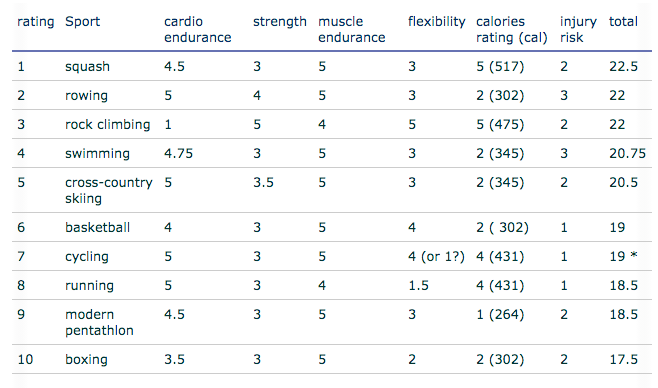In 2003 Forbes first published their list of the 10 healthiest sports, based on a calculation using four physiological components of fitness, plus injury risk and energy expenditure. Squash was ranked at the top of the list. The original source for this study can be found here https://www.forbes.com/2003/10/01/cx_ns_1001feat.html#4efd191e185c
Top 10 List of Healthiest Sports
The sport of squash was found to be the healthiest sport, according to Forbes and the calculations based on expert feedback. It is not clear of other sports were also compared and these where the top sports. There are many other sports that should be considered. It is also hard to believe that they rated the injury risk of boxing less than for running and basketball. Anyway, again an interesting exercise, and squash is a worthy winner of the healthiest sport.
note: on all published lists, cycling is listed in 7th position. However, using the data supplied by Forbes, their total rating adds up to 22 which would put them in equal second place. We believe that the flexibility score is wrong and should be 1 instead of 4, and the position in the table is correct.
Method
They chose to compare the sports based on four basic physiological components of fitness: cardiorespiratory endurance, muscular strength, muscular endurance and flexibility, which is just a sample of the 15 factors of success in sports. For each component they asked fitness experts (coaches, personal trainers, competitors and exercise physiologists) to rate them on a scale of 1 to 5, with 5 being “excellent,” 4 being “darn good,” 3 being “good,” 2 being “not bad” and 1 being “nothing special.” Injury risk was rated on a scale of 1 to 3, with 3 being “low,” 2 being “so-so” and 1 being “high.” The energy expenditure rating was based on the calories expended by a 190-pound person over 30 minutes (rates from ACSM), and rated on a scale of 1 to 5, with 5 being 450+ calories, 4 being 400-450 calories, 3 being 350-400 calories, 2 being 300-350 calories and 1 being 250-300 calories. Calorie burn; whenever possible, we selected the rate for “moderate” or similar intensity. The scores for each component was tallied to arrive at an individual rating for each sport.
They chose to compare the sports based on four basic physiological components of fitness: cardiorespiratory endurance, muscular strength, muscular endurance and flexibility, which is just a sample of the 15 factors of success in sports. For each component they asked fitness experts (coaches, personal trainers, competitors and exercise physiologists) to rate them on a scale of 1 to 5, with 5 being “excellent,” 4 being “darn good,” 3 being “good,” 2 being “not bad” and 1 being “nothing special.” Injury risk was rated on a scale of 1 to 3, with 3 being “low,” 2 being “so-so” and 1 being “high.” The energy expenditure rating was based on the calories expended by a 190-pound person over 30 minutes (rates from ACSM), and rated on a scale of 1 to 5, with 5 being 450+ calories, 4 being 400-450 calories, 3 being 350-400 calories, 2 being 300-350 calories and 1 being 250-300 calories. Calorie burn; whenever possible, we selected the rate for “moderate” or similar intensity. The scores for each component was tallied to arrive at an individual rating for each sport.
The health benefits of squash
- Burn calories – All that rallying makes continuous energy demands of your muscles, giving you little recovery time, which is good news for weight loss!
- Improve your aerobic fitness to boost your heart, muscle and lung endurance
- Boost your flexibility thanks to the lunging and stretching motions
- Develop strength and power in your arm and leg muscles
- Improve hand-to-eye co-ordination – those squash balls can be speedy little buggers!
- Boost cardiovascular fitness so more oxygen can be pumped through to body to energise your muscles
- Boost mental strength and concentration – matches can last a while!
- Easy to get into


